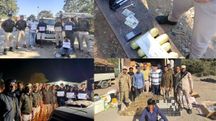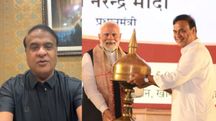Assam's Golaghat family sustains generations of pottery creating 50,000 'diyas' for a greener 'Diwali'
An Assam family in Golaghat keeps their pottery tradition alive by producing 50,000 'diyas' for a greener Diwali. Their efforts highlight a growing demand for eco-friendly alternatives over plastic.
 Assam's Golaghat family sustains generations of pottery creating 50,000 'diyas' for a greener 'Diwali'
Assam's Golaghat family sustains generations of pottery creating 50,000 'diyas' for a greener 'Diwali'In the midst of India's push towards sustainable development and the 'Aatmanirbhar Bharat' , a family in Assam's Golaghat district stands as a beacon of tradition, keeping the ancient art of pottery alive for over five generations. As Diwali approaches, this family's commitment to crafting around 50,000 traditional earthen lamps, known as diyas not only preserves a rich cultural heritage but also aligns with the growing emphasis on environmental consciousness.
Diwali, the festival symbolizing the triumph of light over darkness and good over evil, is celebrated with great enthusiasm across India. However, the very form of art integral to this celebration is under threat. The family from Golaghat with a heritage spanning five generations is not only keeping the flame of tradition alive but also embodying the spirit of 'Aatmanirbhar Bharat' by sustaining their pottery business through the generations.
In the context of the G20 summit in 2023, with a thematic focus on "LiFE" (Lifestyle for Environment), the family's dedication to crafting eco-friendly diyas aligns seamlessly with India's commitment to environmentally sustainable practices. These diyas made from the finest clay extracted from rural sources decompose naturally contributing to a cleaner environment.
Rahul Kumar, a skilled potter from Golaghat, shares insights into their time-honored craft. "Our family has been in the pottery-making business since the time of the British. This is not merely a livelihood for us; it's a legacy passed down through generations. Crafting each diya is a labor-intensive process, requiring meticulous effort and skill. For five generations, my forefathers have honed this craft, and we continue to uphold their legacy."
The family's commitment to their craft is evident as they tirelessly work to meet the demand for Diwali. "We've produced between 40,000 to 50,000 diyas for this year's Diwali celebrations. Typically, we receive orders ranging from 1,000 to 2,000 diyas. While it is a labor of love, financial sustainability remains a challenge. Our family has not received government support yet, and we hope that recognition and assistance will come our way," says Rahul Kumar.
The process of crafting each diya involves the use of specific materials sourced from the region. Rahul explains, "To make the diya, we require sand, mud, and a special clay known as 'Kuma mati.' We use mango tree bark for coloring the diyas. The 'Mela Mati' we use, sourced from Titabor forms the base material. The process involves a significant financial investment, with a pickup truck of soil and mud costing us between Rs 7,000 to 8,000."
In their pursuit of sustaining tradition, the family faces both challenges and triumphs. "The market dynamics are challenging, and we sell each diya for as little as Rs 1, sometimes even at 80 paisa. While the profit margin may be modest, our family's resilience and commitment keep this craft alive. The diya, made from clay or mud with a cotton wick dipped in oil or ghee, is an integral part of Diwali celebrations. We hope that our efforts inspire others to appreciate and support traditional crafts like ours," Rahul Kumar adds.
As the world moves towards a more sustainable future, initiatives like the Golaghat family's pottery business exemplify the harmonious coexistence of tradition and environmental consciousness. With Diwali approaching, there is an opportunity for individuals and the government alike to recognize and support such endeavors ensuring the preservation of cultural heritage and the promotion of sustainable practices for generations to come.
Copyright©2025 Living Media India Limited. For reprint rights: Syndications Today









